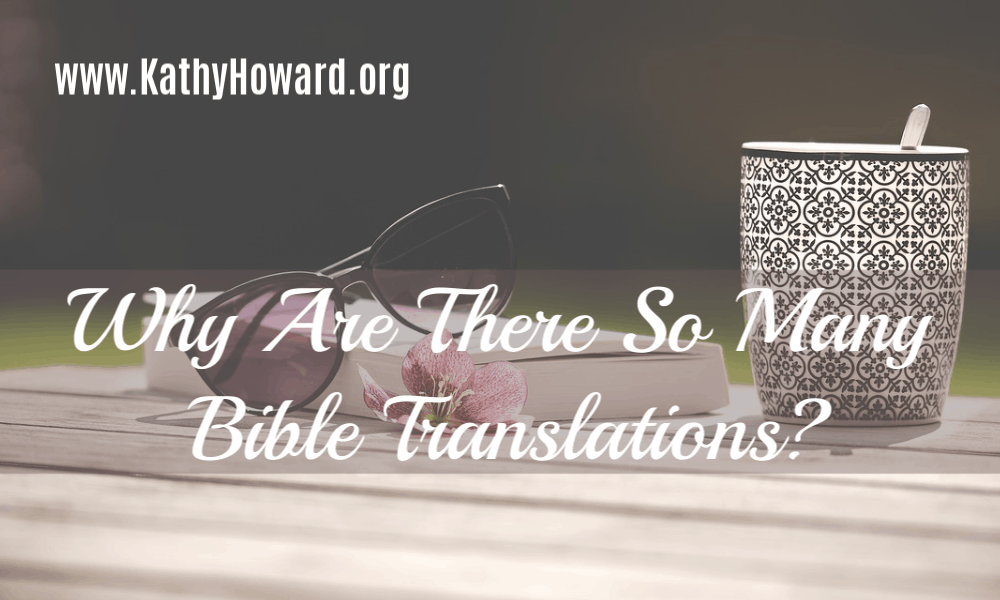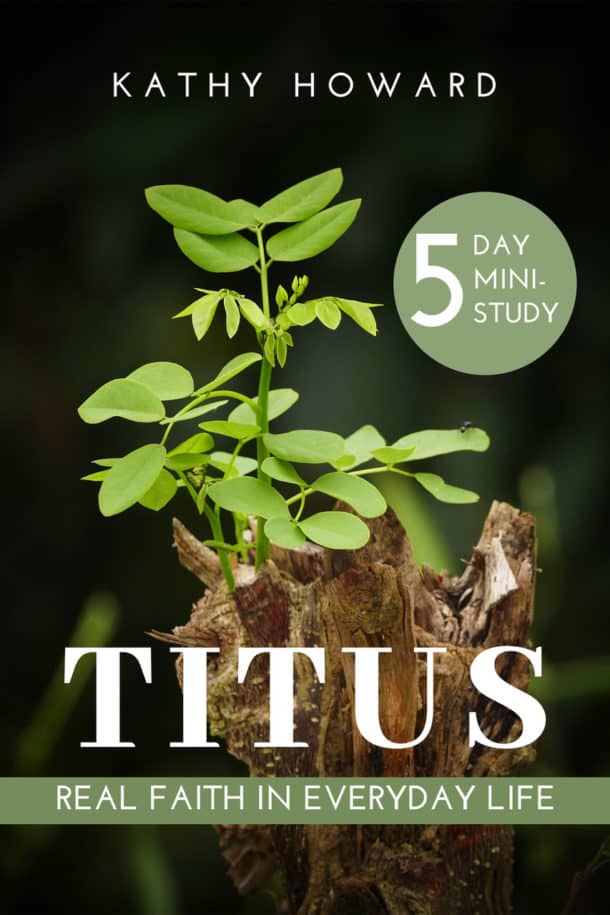
So. Many. Choices. Really, why do we need so many different Bible translations? Isn’t one enough? Unless we read Hebrew and Greek – the original languages of the Bible – we must choose from the many English translations of the Bible. But there are dozens and dozens to choose from. How do we decide? Do we need more than one?
Why do so many different Bible translations exist?
If you speak more than one language, you know that everything doesn’t easily translate between one language and the other. Sometimes you have to make choices. And, if these languages are based in very different cultures, you also know that even if the words translate, the meaning may still get lost. (See “Resources to Study the Bible’s Greek & Hebrew Words.”)
The Bible was not only written in a different language than ours, it was written in the context of a very different culture and time in history. Translators of the Bible have to consider not only the language but also the culture and the many changes brought by thousands of years. Even everyday things like units of measurements, money, calendars, and the way we keep time have changed. (See also “Mind the Historical and Cultural Gap of the Bible” and “Who Wrote the Bible and Why Does it Matter?“)
Range of Translations Philosophies
Bible Translations are done by a team of biblical scholars. (The few exceptions are for paraphrases, not translations. For instance, The Message paraphrase was done by an individual.) The primary reason English translations differ depends on the philosophy of translation used by the translation team.
The translation philosophy determines how far the translators will go to bridge the gaps between the languages, culture, and time. They must decide what balance they’ll find between staying true to the original language and making it understandable to the reader.
Four Basic Groups of Bible Translation Philosophies
There are some defined groupings of translations, but they all fall along a spectrum from highly literal to highly paraphrased. (Feel free to download this Bible Translation Chart PDF!) Keep in mind there is no perfect literal translation from one language to another because of inherent differences in the structure and vocabularies of languages. The Bible is inerrant in the original manuscripts, not the human translations. (For more on this see “What we Misunderstand about Bible Translations” by Katie Orr.)
- Formal Equivalent (also known as Word for Word, literal) – These translations are the closest to the grammar and syntax of the original language, but they can often sound wooden. Also, this kind of translation makes no consideration for cultural changes. (Ex: Amplified, KJV, ESV, NASB, RSV, ASV.)
- Dynamic Equivalent (also known as Thought-for-thought) – These translations work to keep the overall original thought rather than attempt a literal word for word translation. Although not as technically accurate as the Formal Equivalent, they are much easier for 21st century westerners to understand. For instance, Dynamic Equivalent translations change idioms, figures of speech, and measurements into “equivalent” terms that we will understand, but also try to maintain historical and factual accuracy. (Ex: NLT, CEB, REB) Example of a need: Translating “it’s raining cats and dogs” into another language.
- Optimal Equivalent – This “in-between” philosophy group is not on all the lists. But the NIV is the prime example. Desire to soften the stilted reading of the Formal Equivalent but still stay closer to the original language than the Dynamic Equivalent. (NIV, NJKV, CSB, NRSV)
- Paraphrase (Free) – This group departs the furthest from the original language but it provides a fresh reading experience. A paraphrase is not technically a translation but more of a big-idea-for-big-idea. It takes liberties with the literal words to create a “storytelling” feel. This translation group is fine for casual and inspirational reading but not recommended for study. With the paraphrase’s “storytelling” format, it would be great for family devotions with young children. (Ex: The Message, The Living Bible, Phillips)
The Translations I Use
When I read my Bible each morning, I usually read from two different translations to expand my understanding of the passage. First, I read it from a Word-for-Word translation since that will be more literal. I use the ESV. Then I read it in the NLT, a thought-for-thought transition, to help explain some of the more “stiff” places in the ESV. However, I use the NIV for memorization because that’s the translation I used for decades and many passages are more familiar to me from the NIV. There are so many great translations. And the good thing is, we don’t have to use just one! (See also “3 Steps to Help You Choose a New Bible.”)
A more literal translation is best for study, but a thought-for-thought or paraphrase is great for devotional reading or family devotions.
What translation do you use? Which one would you like to try?


I’ve often wondered if it was wrong to read many of the translations out today. I’m a KJV myself but I have read a few others when they are in studies I’m doing. I want the closest to the original text without changing the meaning. This is just what I’ve wanted to know. Thank you.
If you’re looking for the most literal translation from the best manuscripts you may want to consider the NASB or the ESV. They are solid word-for-word translations. Since the KJV was completed in 1611, older manuscripts of the New Testament have been discovered. The NASB and the ESV are based on the oldest manuscripts.
Kathy, I would love a thought on how to communicate to a young believer that the Message is not a”bible”. How would you express that?
That’s a tough one. Technically, since it’s a Bible paraphrase, it’s quite far from the literal meaning of the text. But also the easiest for a young believer to understand. Perhaps you could gift them a Bible that moves them a little more in the right direction without going all the way to word-for-word. I love the NLT for devotional reading. It’s easy to understand but maintains a good faithfulness to the Word. If you get them even a step further to the NIV, that would be great. Maybe you could explain that the paraphrase sacrifices accuracy for ease of reading and that you believe that are ready to “trade up?!”
Kathy, I am very concerned about how nonchalant you are regarding the use of paraphrased Bibles, ESPECIALLY the NLT. A paraphrase (as you well know) is a person reading the script and basically rewriting it based on THEIR understanding of the meaning of what they read, which may not necessarily convey what GOD’S intent is. The fact that you have been teaching God’s Word for over 30 years etc and believe that a paraphrased Bible correctly conveys it explains how Christian society has become so secular in outlook and attitude.
Hi Karama, thank you for stopping by, reading, and commenting. I am sorry you are concerned, but I think you are misunderstanding both the nature of translations and my post. For instance, the NLT is a translation, not a paraphrase. Like all true translations, it was done by a team of biblical scholars using the best manuscripts in the original language. But it is a dynamic translation and not a formal equivalent, which is the very reason I do not use it as my primary study translation but rather as a secondary translation to aid my understanding. The NLT is a solid translation, but I do use the formal equivalent for primary study and teaching. You are right that many in our churches have become secular in outlook and attitude. Our churches need solid, biblical teachers and I strive to be that at all times.
My favorite is the NLT. My church started memorizing the book of Philippians during the lockdown. Even though they are using the ESV, I’m using the NLT. I do use the ESV at church and for in-depth, word-for-word studies. But I find that I get too bogged down in the details and forget the bigger context, so I use the NLT more often now, for Bible journaling, memorizing, and most Bible studies. If I need to check the accuracy of a word, I’ll go to BibleHub.com and look up the original language.
That’s awesome that your church is memorizing Philippians! I am just finishing up having the book memorized, but I’ve been working on it about 18 months. How are you doing with it?
We just finished chapter 2, so we’re more than halfway through (as chapters 3 & 4 are not as long).
I was more familiar with those chapters too!
How does BibleHub.com work? This is the first I have heard of it.
Hi Joan! The BibleHub is an online resource with all kinds of tools like Bible dictionary, concordance, and original languages. I have not really used it. But I often use BlueLetterBible.org to look up the original Greek and Hebrew words. With that online tool, if you are reading in the KJV, you can “turn on” the “Strong’s” language numbering system to access the definitions for the Greek or Hebrew.
I grew up with the KJV. I didn’t get KJ any more than I got Shakespeare. I, too, am a big picture person….Love with your heart. Express it with your hands. Let people see Jesus in you every day. I think you may have inspired me dust off a NLT that I have.
My New Testament professor at seminary recommended the NLT to me as good change for my devotional reading!
A son-in-law was a student at DCC years ago. He’d push a discussion until I’d look at him and say, “Did you know that Jesus loves me. This I know, for the Bible tells me so?”….There’s a reason I always worked with children 🙂
Nice post. We are lucky to have so many tools.
Hi my name is Shelli, and I have a wandering mind. Not fond of reading, but I do read God’s Word everyday. I feel like I’m not getting anywhere though. Any suggestions?
Hi Shelli! My name is Kathy and I also have a wandering mind! For prayer and Bible reading, using a journal and making notes in my Bible helps keep me focused. Also, maybe a group will help. I’d be honored if you’d check out a Bible reading group I lead on Facebook! https://www.facebook.com/groups/ReadingTheBibleTogether/
Hi Kathy! Thank you so much for responding! I don’t have Facebook. And I don’t do group Bible studies because I’m deaf. And to top it off I don’t know sign language either lol. So I try to manage the best I can with online devotionals and YouTube Bible studies with Andrew Womack Ministries.
Sounds like you have access to some great resources! I love how God uses technology!
They have close captions on YouTube videos. That’s why I like YouTube. Have a blessed day!
What translation do you use?
Use the NWT version for study and for journaling I use the NIV, the New KJ is useful to me as well. The NWT is an English translation that is easy to read and has gone back as far as humanely possible to the original Hebrew-Aramaic writings and the Greek writings. The Bible in it’s original purpose was to be written in an everyday language so that farmers, shepherds, fishermen etc. Could read and understand the BIble, not in Latin for just a few to read, this version is without the flowery language of thou and thy. That’s why I use it.
Hi Andrea, thanks for stopping by and leaving a comment! Are you a member of the Jehovah Witnesses? I only ask since the New World Translation is a translation by and for the Jehovah’s Witnesses and is not considered a reliable translation by Christian scholars. If you are looking for an easy to read reliable translation, the New Living Translation (NLT) is solid.